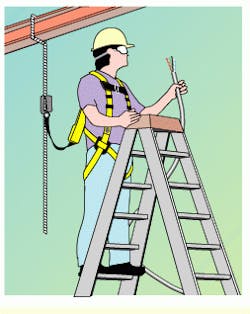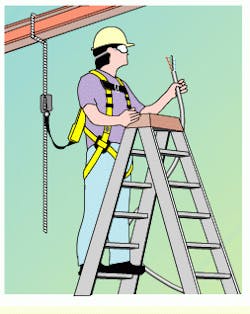Prevent falls at the job site
Brian Kingman
Consolidated Services Group
Problem
Each year, workers are injured by falls at the job site; working while on scaffolding or a ladder can result in severe injuries. What can you do to prevent falls?
Solution
Monitoring worker safety at the job site can be made easier by complying with the Occupational Safety and Health Administration (OSHA) regulation for fall protection, 29 CFR 1926.500. First, however, you must understand these fall-protection requirements under subpart M of this regulation.
To ensure the proper selection and use of equipment for the application, you should read all four parts of this section. Because the equipment and application may vary in different situations, it is important to provide the appropriate equipment for each task.
Suggestions for fall protection
1) Determine the proper equipment. Ask yourself if the task would be safer to perform from a lift, staging or ladder.
Ensure working area and walkways are free of debris.
2) If a personal fall-protection system is used, ensure that anchorage points are properly rated.
3) Before using any fall-protection devices, such as safety belts or harnesses, inspect them. If any component is damaged, remove it immediately from service.
4) Verify that all guard-rail systems are properly installed and include toe boards and a midrail.
5) If a guard rail must be removed temporarily to facilitate your job, replace it as soon as possible.
6) If aerial lifts are used on the job site, have all personnel certified in their use.
7) Make sure that all through-floor openings are covered and marked with an appropriate warning.
8) Ensure that all employees are trained to recognize potential fall hazards and how to select and use fall-protection devices.
This is by no means a complete listing of equipment or the requirements for fall protection. A complete explanation of requirements and specifications can be found in 29 CFR 1926.500 of the Occupational Safety and Health Administration (Washington, DC).
Lightweight, step-in-type harnesses are easy to use for fall protection. Just step into the leg straps, pull the harness up over your shoulders, connect the chest strap and attach the harness to the anchorage point.
Brian Kingman is safety officer at Consolidated Services Group, Norwood, MA.

